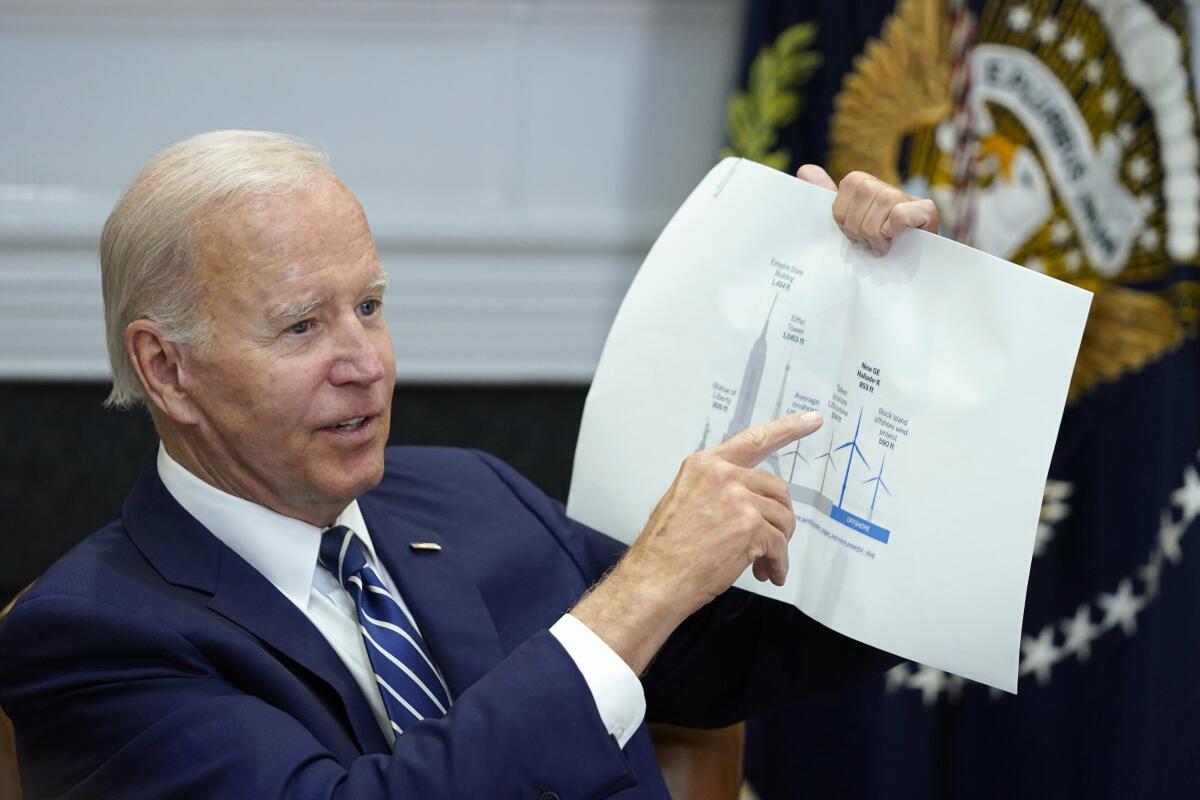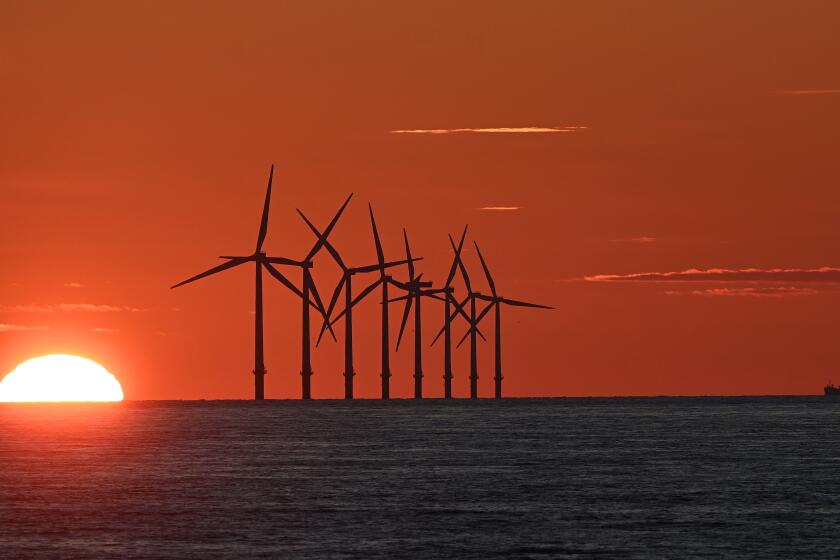Biden plans floating platforms to expand offshore wind power

- Share via
WASHINGTON — The Biden administration on Thursday announced plans to develop floating platforms in the deep ocean for wind towers that could power millions of homes and vastly expand offshore wind energy in the United States.
The plan would target sites in the Pacific Ocean off the California and Oregon coasts, as well as in the Atlantic in the Gulf of Maine.
President Biden hopes to deploy up to 15 gigawatts of electricity through floating sites by 2035, enough to power 5 million homes. The administration has previously set a goal of 30 GW of offshore wind energy by 2030 using traditional technology that secures wind turbines to the ocean floor.
There are only a handful of floating offshore platforms in the world — all in Europe — but officials said the technology is developing and could soon establish the United States as a global leader in offshore wind energy.
The push for offshore wind energy is part of Biden’s effort to promote clean energy and address global warming. Biden has pledged to cut greenhouse gas emissions in half by 2030. A climate and tax bill he signed last month would spend about $375 billion over 10 years to boost electric vehicles, jump-start renewable energy such as solar and wind power, and develop alternative energy sources such as hydrogen.
“Today we’re launching efforts to seize a new opportunity — floating offshore wind — which will let us build in deep water areas where turbines can’t be secured directly to the seafloor, but where there are strong winds that we can now harness,” White House climate advisor Gina McCarthy said at a news conference Thursday.
Billionaire Phil Anschutz — who owns the Coachella music festival, the Los Angeles Kings hockey team and L.A.’s Crypto.com Arena — is preparing to build the nation’s largest wind farm. We traveled the route.
Deep water areas in the Pacific especially have potential to vastly expand offshore wind energy in the U.S., McCarthy and other officials said.
McCarthy acknowledged that the floating technology is at an early stage. But she said “coordinated actions” by federal and state officials, working with the private sector, can position the U.S. “to lead the world on floating offshore wind and bring offshore wind jobs to more parts of our country, including the West Coast.”
Two pilot projects are planned off the north and central California coast, and a third is planned in southern Oregon, officials said.
Oregon Gov. Kate Brown said her state and California have some of the best wind resources in the world, and called floating platforms crucial to develop them because of the depth of the ocean floor along the West Coast.
Heather Zichal, chief executive of the American Clean Power Assn., an industry group, called the announcement a “game changer” that will spark investment in a new domestic supply chain and allow the U.S. to lead in this emerging technology. Along with incentives in the sweeping climate and tax bill, Zichal said, she expects costs for offshore wind development to dramatically decrease, allowing deployment of clean energy at the scale needed to address climate change.
A plan to float wind power turbines in waters off Santa Barbara County has struck opposition from a Native American tribe and environmentalists.
The Energy Department announced nearly $50 million, including funding from the bipartisan infrastructure law Biden signed last year, for research, development and demonstration work to support floating offshore wind platforms. Officials aim to cut the cost of floating offshore wind energy 70% by 2035, to $45 per megawatt hour, Energy Secretary Jennifer Granholm said.
“We think the private sector is going to quickly see the real opportunity here not only to triple the country’s accessible offshore wind resources but to make the U.S. a global leader in manufacturing and deploying offshore wind,” she said.
Emerging technology for floating platforms “means there’s real opportunity for greater energy security,” affordability and “tens of thousands of good-paying, in-demand jobs,” such as electricians, engineers, shipbuilders and stevedores, Granholm said.
The Biden administration “is all in on making floating offshore wind a real part of our of our energy mix and winning the global race to lead in this space,” Granholm said. ”And that’s why we set this big, hairy audacious goal” of 15 gigawatts of floating offshore wind by 2035.
Interior Secretary Deb Haaland said her department has approved the nation’s first two major offshore wind projects in federal waters and has begun reviewing at least 10 more. An offshore wind lease sale off the New York and New Jersey coast set records, she said, and a lease sale also was held in North Carolina. Seven lease sales for offshore wind projects are planned by 2025.
The U.S. plans to pursue more use of wind energy and offshore wind farms.
More than half the nation’s offshore wind resources are in deep waters where traditional offshore wind foundations are not economically feasible, Haaland said, adding that “floating wind will help us reach areas once not attainable. And this is critical because floating wind will help us build on the administration’s goal of 30 gigawatts of offshore wind by 2030.”
The world’s first floating wind farm has been operating off Scotland’s coast since 2017. Norway-based Equinor, which operates the 30-megawatt Hywind Scotland project, is building a huge, floating wind farm off Norway to provide electricity for offshore oil and gas fields.
Lauren Shane, a spokeswoman for Equinor in the United States, said the company is upbeat about floating offshore wind energy and will evaluate possible opportunities in the U.S. “We’re excited about the development of offshore wind in the U.S.,” she said.
Another offshore wind developer with projects in the United States, Denmark-based Orsted, also applauded the administration’s efforts.
“The administration’s innovation priority is well placed, and with the right investment and public-private partnerships,” floating platforms “can expand deployment, drive down costs and bring more clean energy to millions of Americans,” said Bryan Stockton, head of regulatory affairs for Orsted North America.
More to Read
Get the L.A. Times Politics newsletter
Deeply reported insights into legislation, politics and policy from Sacramento, Washington and beyond. In your inbox twice per week.
You may occasionally receive promotional content from the Los Angeles Times.













